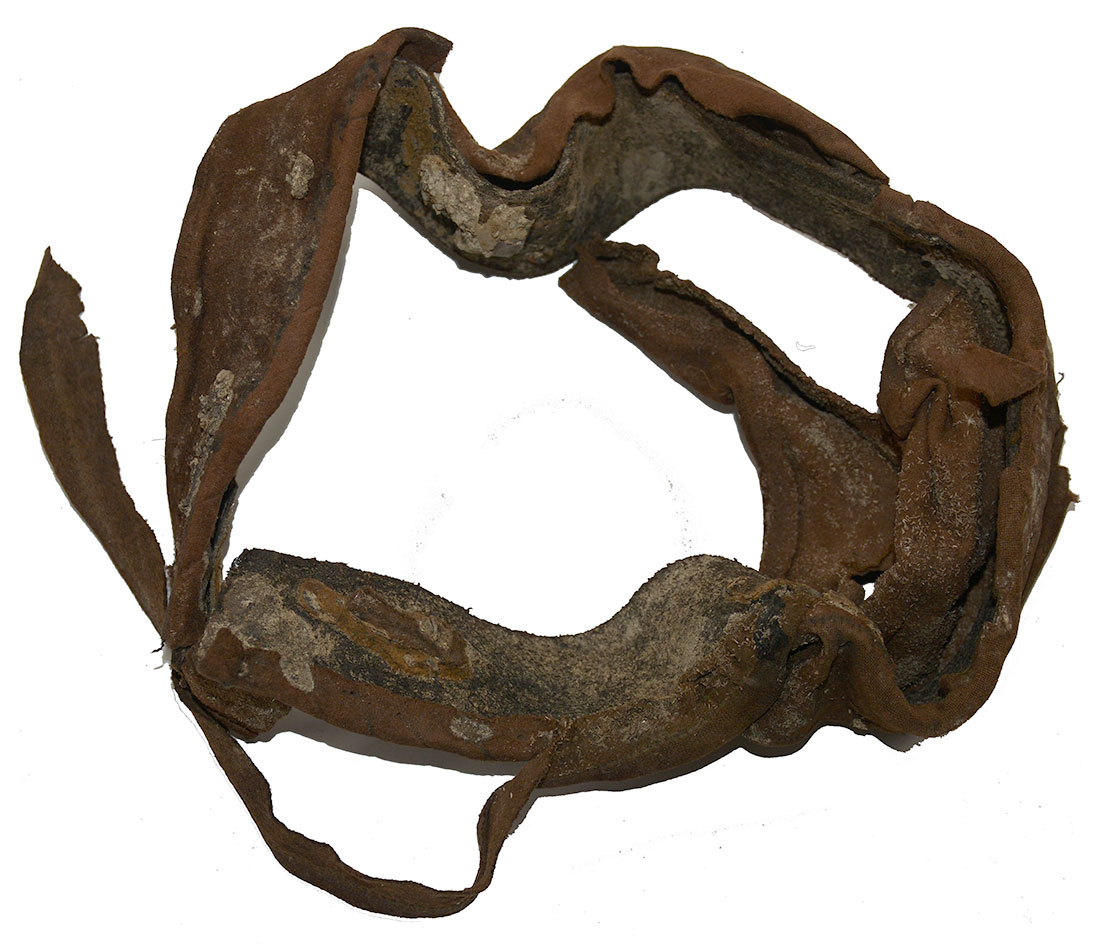site search
online catalog
RELIC KEPI PIECES FROM AN INDIAN WARS US ARMY FRONTIER FORT

$75.00 SOLD
Quantity Available: None
Item Code: 1052-1103
This is the lower portion of a soldier’s kepi from excavations at Fort Pembina, ND. This includes much of the lower band of the cap and the interior stiffener or part of the sweat band. The fabric has shifted in color from blue to light brown from the soil conditions, which also preserved it, and shows white and gray stains. The fort was established in 1870 by troops of the 20th US Infantry and garrisoned until 1895. As would be expected from an early Indian War post, pieces from the dig are a mix of Civil War commercial and issue items retained by soldiers, sold by retailers from old inventory, or issued by the army out of surplus stocks, along with later material, both commercial (i.e., private purchase) and issue.
Situated in the Red River Valley in North Dakota near the Canadian border, Fort Pembina was established in 1870 and in operation until 1895. Trading posts existed earlier in the area as part of the fur trade, and the first U.S. military post there was temporary- manned by a detachment of Minnesota troops in 1863-1864 following the 1862 Sioux uprising. In March 1870 a new fort was established south of the Pembina River and about 200 yards west of the Red River, completed by July and named in honor of Gen. George H. Thomas. The name was changed to Fort Pembina in September and the initial garrison consisted of two companies of the 20th US Infantry. Their main duty was to provide security for settlers worried about Sioux returning south from Canada, escort boundary surveys along the Canadian border, and, ironically, prevent raids north into Canada by Fenian groups.
The fort included enlistedmen’s barracks, officers’ quarters, guard house, ordnance storehouse, company kitchen, root house, laundress’s quarters, quarters for civilian employees, hospital and hospital servant’s house, a barn for the “hospital cow,” quartermaster and commissary offices and storehouse, stables, wagon shed, etc. The garrison reached peak strength in 1878 of 200, but the average was about 125 enlisted men and 8 officers. An October 1885 return listed 97 men, 2 field pieces, 1 mountain howitzer, 100 rifles, 19 pistols, 23 mules, and 9 wagons. By 1890 the post had just 23 men, and after an 1895 fire destroyed some 19 buildings it was decided to abandon the fort rather than rebuild, the last detachment left in September. The property was turned over to the Interior Department and later sold in 1902.
The excavations were done on private property with the owner’s permission and are a real window on the daily life and material culture of the garrison, much which would never have been brought home or even thought worthy of mention by most veterans. [sr][ph:L]
~~~~~~~~~~~~~~~~~~~~~~~~~~~~~~~~~~~
THIS ITEM, AS WITH ALL OTHER ITEMS AVAILABLE ON OUR WEB SITE,
MAY BE PURCHASED THROUGH OUR LAYAWAY PROGRAM.
CLICK HERE FOR OUR POLICIES AND TERMS.
THANK YOU!
Inquire About RELIC KEPI PIECES FROM AN INDIAN WARS US ARMY FRONTIER FORT
For inquiries, please email us at [email protected]
Most Popular
Historical Firearms Stolen From The National Civil War Museum In Harrisburg, Pa »
Theft From Gravesite Of Gen. John Reynolds »
Selection Of Unframed Prints By Don Troiani »
Fine Condition Brass Infantry Bugle Insignia »
Wonderful Condition Original Confederate-Manufactured Kepi For A Drummer Boy Or Child »
featured item
THEFT REPORTED AT AUTUMN GETTYSBURG SHOW
A vendor at the Autumn Gettysburg Civil War show held at the Allstar Events Complex on Oct. 28-29 reported that a Maryland sword belt plate valued at $3500 was stolen from a display case on Sunday afternoon. The Gettysburg Times published a… . Learn More »





